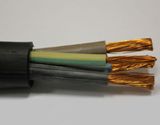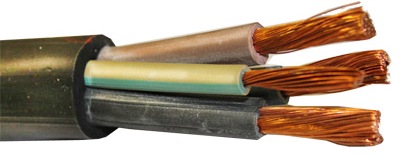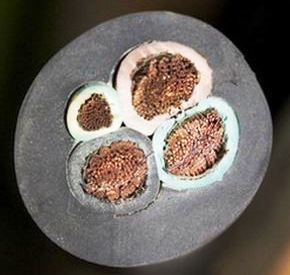Technical characteristics of the KG cable and options for its laying
 KG — flexible copper cable with round design. The insulation of the current-carrying wires is made of RTI-1 brand rubber based on natural rubbers. The general insulation of the cable is made of rubber hose type RShT — 2 or RShTM — 2, consisting of isoprene and butadiene rubber.
KG — flexible copper cable with round design. The insulation of the current-carrying wires is made of RTI-1 brand rubber based on natural rubbers. The general insulation of the cable is made of rubber hose type RShT — 2 or RShTM — 2, consisting of isoprene and butadiene rubber.
In the power cables of the KG brand, the first layer of insulation of the conducting wire can be a synthetic polyethylene terephthalate film of the PET-E type, which prevents the conducting wire from sticking to the insulation. Also, this film can be used as a protective-separation layer, ensuring the lack of adhesion of the core insulation to the main insulation. The wire itself is multi-wire, copper, according to GOST standards, it has 5 performance classes.
KG brand cables are produced with a large selection of cross-sections from 1 sq. mm to 185 sq. mm and the number of cores from 1 to 5.
In most cases, the wires of the KG cable are color coded:
-
Blue - neutral
-
Brown - phase
-
Black - phase
-
The ground wire is insulated and has a yellow-green color
KG cables are designed for connecting portable power units, mobile devices, mobile machines, welding machines of various types… The cables are designed to carry alternating and direct current up to 400 Hz. and voltage 0.66 and 1 kW.
The working temperature of the cable is from — 40 ° C to + 50 ° C. The working temperature of the wire should not exceed + 75 ° C, and the flexibility of the cable is at least 8 of its outer diameters.
The life of the cable of this brand is 4 years. KG cable is resistant to sunlight and moisture and is the best cable for outdoor use.
KG cable laying options
1. In the pipes.
To protect the cable from mechanical damage and destruction of the insulation from aggressive environments in open installation areas, a method of laying cables in pipes of the following types is used:
-
Pvc
-
Steel
-
Asbestos cement
-
Ceramic
Laying cables in pipes is carried out in accordance with the rules for electrical installations (PUE). The joints of the pipes in the joints must be tight and do not allow the penetration of the surrounding media into the pipes, for this, sealed connectors are installed at the joints, and at the entrances and exits of the cables from the pipes, it is tightly sealed with resin tape, heat-shrinkable materials, as well as special yarn. When laying cable in pipes, the diameter of the pipe should be 2 - 2.5 times the diameter of the cable to be laid.
2. On trays.
For laying in trays, use a cable with a cross-section of less than 16 sq. mm. This method of laying is used in industrial premises with a chemical environment, as well as in wet and dry category. At the same time, the installation of the tray on ceilings and surfaces is carried out in accordance with the regulatory documents and the design of this room.The cables are laid with a gap along the entire width of the tray in one layer.
3. Aerial performance.
KG cable has the possibility to install ropes, overpasses. When laying in this way, the technical characteristics of the places of laying must be taken into account, as well as the possibility of damage, breakage of the cable by a mechanical method.
4. In the ground.
This method of laying the KG cable is impossible, because it is an unreliable type of installation. Without protection against mechanical damage, there is a possibility of damage to the cable from construction debris, hard soil, etc., which will lead to unstable operation of the cable.
5. By open method.
This type of cable can be laid open without additional protection. Elimination of the possibility of mechanical damage, as well as the mass gathering of people, a certain height of the suspension of the cable in the regulated passages electrical installation rules (PUE) and prevent the possibility of bending and pinching of the cable by mobile machines and aggregates.
All types of work are performed by qualified personnel authorized to perform these activities, as well as in compliance with all norms and rules.


